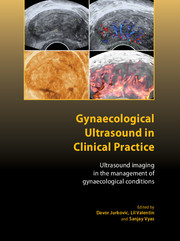 Gynaecological Ultrasound in Clinical Practice
Gynaecological Ultrasound in Clinical Practice Book contents
- Frontmatter
- Contents
- About the authors
- Abbreviations
- Preface
- 1 Ultrasound imaging in gynaecological practice
- 2 Normal pelvic anatomy
- 3 The uterus
- 4 Postmenopausal bleeding: presentation and investigation
- 5 HRT, contraceptives and other drugs affecting the endometrium
- 6 Diagnosis and management of adnexal masses
- 7 Ultrasound assessment of women with pelvic pain
- 8 Ultrasound of non-gynaecological pelvic lesions
- 9 Ultrasound imaging in reproductive medicine
- 10 Ultrasound imaging of the lower urinary tract and uterovaginal prolapse
- 11 Ultrasound and diagnosis of obstetric anal sphincter injuries
- 12 Organisation of the early pregnancy unit
- 13 Sonoembryology: ultrasound examination of early pregnancy
- 14 Diagnosis and management of miscarriage
- 15 Tubal ectopic pregnancy
- 16 Non-tubal ectopic pregnancies
- 17 Ovarian cysts in pregnancy
- Index
4 - Postmenopausal bleeding: presentation and investigation
Published online by Cambridge University Press: 05 February 2014
- Frontmatter
- Contents
- About the authors
- Abbreviations
- Preface
- 1 Ultrasound imaging in gynaecological practice
- 2 Normal pelvic anatomy
- 3 The uterus
- 4 Postmenopausal bleeding: presentation and investigation
- 5 HRT, contraceptives and other drugs affecting the endometrium
- 6 Diagnosis and management of adnexal masses
- 7 Ultrasound assessment of women with pelvic pain
- 8 Ultrasound of non-gynaecological pelvic lesions
- 9 Ultrasound imaging in reproductive medicine
- 10 Ultrasound imaging of the lower urinary tract and uterovaginal prolapse
- 11 Ultrasound and diagnosis of obstetric anal sphincter injuries
- 12 Organisation of the early pregnancy unit
- 13 Sonoembryology: ultrasound examination of early pregnancy
- 14 Diagnosis and management of miscarriage
- 15 Tubal ectopic pregnancy
- 16 Non-tubal ectopic pregnancies
- 17 Ovarian cysts in pregnancy
- Index
Summary
Introduction
Postmenopausal bleeding is the most common presentation of malignant disorders of the endometrium. Its prevalence in the general population is estimated to be 40.9% (95% CI 21.8–77.1%) immediately after the first 12 months of amenorrhoea following menopause, falling to 4.2% (95% CI 1.7–10.2%) more than 3 years after menopause. The reported prevalence of malignancy in women presenting with bleeding after menopause varies between 5% and 15%. It is therefore mandatory that all women presenting with postmenopausal bleeding undergo further investigation. Investigation is directed towards differentiating benign from malignant causes of bleeding, in particular maximising the sensitivity for detection of malignancy, while avoiding unnecessary invasive testing and hospital admissions. Women experiencing irregular bleeding on hormone replacement therapy (HRT) also warrant further investigation, although the time interval between presentation and initiation of investigation is less critical as the risk of malignancy is significantly lower in this group (relative risk 1.3%).
The initial assessment of women presenting with postmenopausal bleeding includes a thorough history and examination. Particular attention should be paid to risk factors including advanced age, obesity, infertility, low parity, family history and history of tamoxifen usage.
This chapter reviews current evidence on various investigative modalities and management planning for women presenting to the gynaecology clinic with postmenopausal bleeding and discusses some of the issues to be considered when planning a cost-effective, clinic-based service for these women.
Keywords
- Type
- Chapter
- Information
- Gynaecological Ultrasound in Clinical PracticeUltrasound Imaging in the Management of Gynaecological Conditions, pp. 29 - 42Publisher: Cambridge University PressPrint publication year: 2009
